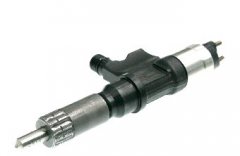Room 503, Building 2, Xinghu Bay, Ningbo City

Principle of fuel injector assembly
Standard fuel injectors can be divided into two categories: axial needle standard injectors and orifice plate standard injectors Among them, there are two types of standard fuel injectors: the S series and T series. The S series is mainly used for debugging fuel injection pumps for small and medium power engines, while the T series is mainly used for debugging fuel injection pumps for high-power engines (such as marine locomotive engine oil pumps); Taizhou Huaxia Petroleum Machinery Co., Ltd. has a variety of orifice plate standard fuel injectors suitable for debugging different types of fuel injection pumps. There are low inertia orifice plate and ordinary orifice plate standard fuel injectors, among which the orifice plate has a diameter of Φ 0.4, Φ 0.5, Φ 0.6, 0.7, and Φ 0.8. The S series axial needle standard fuel injector has been used in China for many years. With the continuous increase in pump end pressure and fuel volume, this product is no longer able to meet the debugging needs of new fuel injection pumps. It can only be used for debugging old varieties of fuel injection pumps (such as: A,B,I, II pump, etc.) The orifice plate fuel injector assembly has been used in developed countries for a long time. Ordinary orifice plate fuel injectors began to be used in the 1960s. With the development of fuel injection pumps, low inertia orifice plate standard fuel injectors have also been widely used. With the large-scale production of P-type fuel injection pumps in China, in order to meet the debugging requirements of this new type of fuel injection pump, low inertia orifice plate standard fuel injectors have been specially developed, which can fully meet PW requirements, PW2000, Wuxi Weifu Hengyang Nanyue Heavy Oil and other oil pump nozzle factories and service stations commonly use low inertia orifice plate injectors, which have achieved very good results It has the following characteristics: (1) high measurement accuracy; (2) The tested flow range is large, and the flow characteristics of various flow ranges can be met by replacing the orifice plate, which can also truly reflect the characteristics of the oil pump; (3) Long service life P-type fuel injection pumps have become increasingly popular in China, and using low inertia orifice plate standard injectors to debug such pumps can effectively solve the problems that arise in the original pump calibration. For example, it is difficult to debug the uniformity of each cylinder, and it is difficult to balance the uniformity of rated speed, maximum torque speed, idle speed, etc; Adjust the oil level accurately Therefore, the correct selection of fuel injectors is crucial for debugging oil pumps, and low inertia orifice plate standard fuel injectors should be selected for debugging P-type fuel injection pumps Some new fuel injection pumps use low inertia orifice plate standard fuel injection pumps with the following requirements:
1、PW、PB、PN、P7100、 The PW2000 pump with a smaller plunger diameter uses a Φ 0.6 low inertia orifice plate standard injector, and the standard oil pipe used is Φ 2X Φ 6X600.
2. The P9 pump and the PW2000 pump with a larger plunger diameter use a Φ 0.8 low inertia standard injector, and the standard oil pipe used for the P9 pump is Φ 3X Φ 8X1000. The standard oil pipe used for the PW2000 pump is Φ 3X Φ 8X600.
3. The BQ PL PM pump uses a Φ 0.5 low inertia orifice plate standard injector, and the standard oil pipe used is Φ 2X Φ 6X600.
4. Other pump types can select suitable standard injectors according to the plunger diameter as described above.
1、 Before using the standard fuel injector assembly, clean the rust proof oil and other dirt with gasoline to keep the entire injector and high-pressure fuel pipe components clean
2、 Before use, check the opening pressure of the standard fuel injector. The opening pressure should be adjusted according to the type of fuel injector purchased. During the initial use, the opening pressure should be regularly monitored and adjusted. After a period of use, the opening pressure should be regularly monitored
3、 The standard fuel injector test oil should comply with the fuel pump calibration oil specified in GB8029 or the "0" light diesel oil specified in GB252. The test oil should settle for at least 48 hours and be well filtered to ensure the cleanliness of the oil quality. The cleanliness of the oil quality has a significant impact on the lifespan of standard fuel injectors
4、 During the experiment, the temperature of the test oil should be controlled at 40 ± 2 ℃
5、 After using the standard fuel injector assembly for a period of time, if there is a significant change in flow rate, it should be checked: ① Is the head of the oil pipe constricted or leaking oil? ② Is there a significant change in the opening pressure? ③ Is there any iron filings or impurities blocking the inlet pipe joint? ④ Is there any iron filings blocking the holes in the orifice plate? ⑤ Is the seat surface of the fuel injector nozzle worn by iron shavings
6、 After using the standard fuel injector assembly for a period of time, it can be disassembled, cleaned, and reassembled with familiarity with the requirements for fuel injector assembly and disassembly. However, do not arbitrarily replace the fuel injector fittings, orifice plates, and high-pressure fuel pipe components to avoid affecting the fuel accuracy of the fuel injector assembly
7、 Standard fuel injectors should be regularly calibrated with a calibration cycle of 6 months